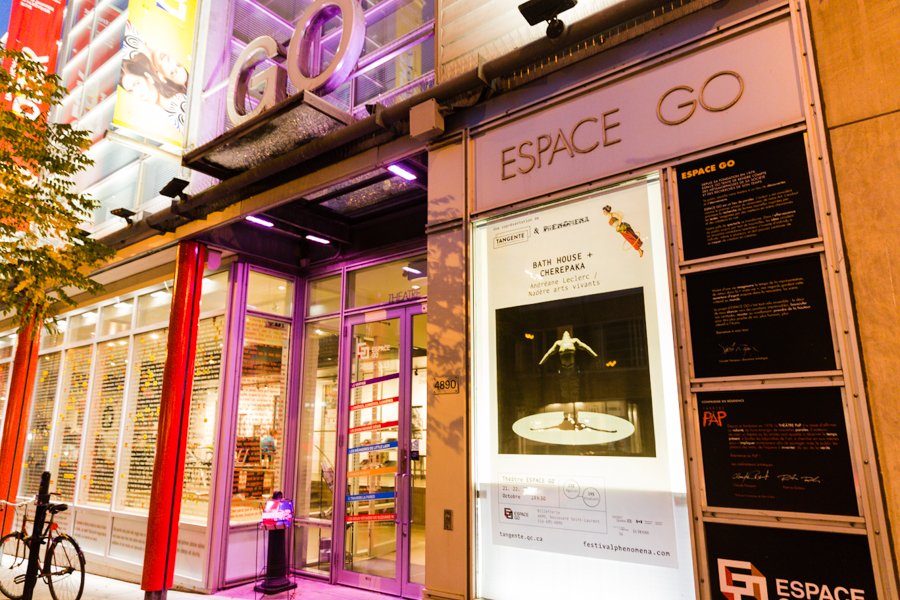Andréane Leclerc first joined Montreal’s National Circus School at the age of nine, and has been practicing the art of contortion ever since. This past week, she brought her skills to Montreal’s Festival Phénomena, a multidisciplinary festival that seeks to promote the avant-garde. In partnership with contemporary dance space Tangente and her company Nadère Arts Vivants, Leclerc directed the movement pieces Bath House and Cherepaka, two powerful explorations of female bodies and their confinement in society. Performed at the relatively small Théâtre Espace Go, the works take place in the space between the seating area and the theatre’s stage, blurring the line between spectator and performer.
Bath House, the first segment of the show, is a ten-minute piece that showcases three performers’ representations of imprisonment. Laurence Racine, Genevieve Gauthier, and Maude Parent flex and bend their bodies within a rectangular area delineated by white tape on the ground, sometimes trying to close the gap between each other and sometimes widening that space. Audience members are asked to stand around this boxed area to create a closed, almost claustrophobic experience for both performers and onlookers. The performers use this rectangle, a physical representation of their prison, to illustrate confinement, alluding to how female bodies are controlled by our patriarchal system. One of the girls contorts around the closed-off area, trying to get out of her ‘prison,’ while another lies on the floor helplessly with ‘chains’ (red ribbons) around her hands and feet. The expressions on their faces combined with their contorted motions give the impression that they are actually imprisoned and trying to break free.
The authenticity of this scene sparks uneasiness in the crowd, all too aware that they are the ones creating this prison.
The second segment of the show, Cherepaka, is a 55-minute performance that similarly uses movement to explore personal and social struggles. Inspired by Gilles Deleuze’s Logique de la sensation and Francis Bacon’s paintings, the piece is choreographed and performed by Leclerc. Cherepaka illustrates the dichotomy between the shell and skin of a turtle. Leclerc uses turtle imagery to represent the symbolic shell that surrounds the self, exploring the universal struggle of being in touch with oneself. The contortionist confines herself to a small circular platform upon which she displays her skill by doing backbends in every possible position. She uses the turtle as a symbol for the dichotomy of inside and outside the self: her clothes and body language are animal-like, a leather bra and light green pants representing the shell, and her bare skin indicating the inner self. Her hands and feet are also covered by brown fabric to hint at the turtle’s feet. Interestingly, her back – the actual location of a turtle’s shell – is left bare.
Leclerc effectively uses her body to represent the struggle of breaking your shell to find what is inside, spending most of the performance with her chest to the ground, moving her legs.
Every time she sluggishly tries to pull herself upright, her body gives way and she falls back onto the ground.
Her performance explores the limits of bodies, and how bodies are limited by the world we live in, demonstrating a struggle that is not just internal but also deals with universal questions of life and death. Accompanying her contortions is Leclerc’s loud, haggard panting and the looks of defeat she gives the audience, indicating that this struggle is an eternal one.
Beyond Leclerc’s individual vocals, the use of sound for atmosphere is key to the audience’s experience of both shows. In Bath House, there is no sound at all, which establishes the mood of the performance. While the audience surrounds the contortionists on the ground, all that can be heard is their breathing, creating a nearly intolerable tension between the contortionists and the silent spectators. As for Cherepaka, the sounds range from birds chirping to eerie, ambient music, allowing the audience to truly believe Leclerc’s depiction of the turtle and its struggle. While it does make the performance more immersive, however, the music is rather stagnant, emphasizing the piece’s already unnecessary length.
The contortion of Bath House and Cherepaka, while somewhat experimental as a form of dance, is expert and precise – every performer seems in control of the slightest tremble in their body. The nearly naked women convey powerful human emotions and experiences, depicting serious struggles but also empowered by the control of their bodies. This show proves that contortion is an art that goes beyond the circus ring, and that some struggles cannot be articulated in speech – sometimes, actions really do speak louder than words.

